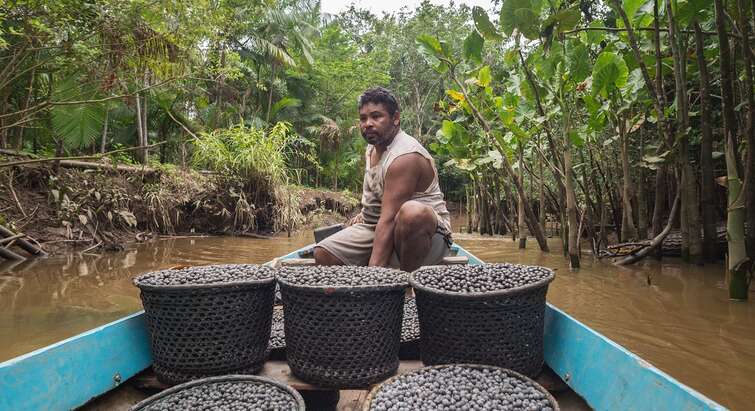Researchers want to convert rapeseed proteins from feed to food
In Denmark and the rest of Europe, you see lots of yellow rapeseed fields and most of the rapeseed protein is used for animal feed. A new research project SEEDFOOD will attempt to change this by creating new fundamental knowledge, so we can use the proteins for food in the future. The research project has been established with a grant of DKK 56 million kroner from the Novo Nordisk Foundation Challenge Programme and is being led from Department of Food Science at University of Copenhagen.

Providing enough proteins through sustainable food production is a huge challenge up to 2050, when the global population is expected to be 9.7 billion people. The proteins we currently get from animal foods create high greenhouse gas emissions, so we have to eat more plant-based foods. Rapeseed is one of our most abundant crops, but at the moment it primarily contributes protein to animal feed.
Read more about SEEDFOOD on the project's homepage
“A lot of rapeseed is grown in Northern Europe, so there is a huge untapped potential in rapeseed proteins if we can solve some of the problems that currently prevent them from being used for food,” explains professor at Department of Food Science at University of Copenhagen (UCPH FOOD), Marianne Nissen Lund, who leads SEEDFOOD.
Rapeseed proteins are currently not used for food due to substances that limit the utilisation of the nutrient content (antinutritional components), an undesirable taste and a lack of functionality in food (e.g., the ability to form desired structures in food).
“Many plant proteins have a low content of the essential amino acids that humans need, which are found in animal proteins. But the content of these essential amino acids is quite high in rapeseed compared to other plant sources, and this is also one of the reasons why we have chosen to investigate how we can process the rapeseed so it is suitable as a healthy and tasty source of nutrition for humans,” says Marianne Nissen Lund.
Push towards sustainability in the food sector
The idea is that the basic knowledge gained in SEEDFOOD can be transferred and utilised by the industry so we can increase the utilisation of rapeseed protein in foods.
“The research idea behind SEEDFOOD was developed in close collaboration between the project partners, which in addition to the University of Copenhagen includes DTU and the Le Mans University in France, and I am excited to lead such a focused effort that can make an impact on the Danish climate agenda,” says Marianne Nissen Lund.
The research grant from the Novo Nordisk Foundation Challenge Programme - Proteins for Tomorrow's Food – is one of the largest investments in Denmark when it comes to basic food research in proteins.
Rapeseed proteins should function in food
The aim with SEEDFOOD is to get the rapeseed proteins to function in food, and the researchers will work with the subject all the way from crushing the rapeseed, to examining how it can be processed so that it works in food, to studying how the proteins are perceived when we eat or drink them, including the taste and mouthfeel, and making sure that they have the right nutritional value. The task is not to come up with specific products, but to provide the basic chemical and physical knowledge that will form the foundation that will allow us to make optimal use of rapeseed in food contexts.

“In the food industry, you are dependent on the proteins you use, for example, having good gelling and emulsifying abilities. This means that they can help build that texture – i.e., mouthfeel – of the food that we like. If it does not work, it is difficult to make delicious food,” explains Marianne Nissen Lund, mentioning yoghurt as a good example: “A yoghurt should be soft and creamy in order for us to like it and not gritty and sticky.”
At the same time, the rapeseed must taste good for us to even consider eating or drinking foods that contain rapeseed protein.
Rapeseed can, for example, be used to make protein-rich drinks, which can be good alternatives to drinking yoghurt and protein drinks that are rapidly growing products in the world market.
Extraction of rapeseed oil damages the proteins
Today, rapeseed is mainly used for the extraction of rapeseed oil, while the residual fraction is the protein, which, as already mentioned, is usually used for animal feed.
“The focus is on getting the oil out in as good a condition as possible, and that often includes processes that involve high temperatures. This means that the protein is damaged,” says Marianne Nissen Lund, who explains that the researchers at SEEDFOOD want to develop much more gentle methods where the protein is not damaged.
In addition, the researchers will isolate the two most abundant rapeseed proteins, napin and cruciferin, which they will examine in greater detail.
“The two proteins have very different properties and therefore also behave very differently in food contexts. This makes it difficult to achieve good functionality, which is why we want to separate them. We will process them using gentle processes, including using enzymes to improve the way they behave in food,” explains Marianne Nissen Lund.
SEEDFOOD will run for a period of six years starting on 1 January 2022.
Read more about SEEDFOOD at the Novo Nordisk Foundation's homepage.
Related News
Contact
Professor at the Department of Food Science at the University of Copenhagen (UCPH FOOD), Marianne Nissen Lund, mnl@food.ku.dk
or
Communications Officer UCPH FOOD Lene Hundborg Koss, lene.h.koss@food.ku.dk
Facts about SEEDFOOD
SEEDFOOD (Functional and palatable plant seed storage proteins for sustainable foods) has been granted DKK 56 million from the Novo Nordisk Foundation Challenge Programme 2021.
Project period: 01.01.2022-31.12.2027.
Professor Marianne Nissen Lund from Department of Food Science at University of Copenhagen (UCPH FOOD) is the project leader together with three co-project leaders:
Professor Alexander Kai Büll, DTU Bioengineering
Professor Taco Nicolai, University of Le Mans
Professor Lilia Ahrné, UCPH FOOD
The researchers will work with the following main themes:
Gentle and sustainable isolation of rapeseed proteins.
Tailored modifications of the rapeseed proteins in order to control the sensory properties of the proteins (including taste and mouthfeel) as well as functionality in food (formation of desired textures in food, etc.).
Gain an understanding of how rapeseed proteins interact with other food and saliva components at the molecular level.
To create the desired functionality, taste and structure of the rapeseed proteins so that they can be used for new, sustainable and tasty foods with a good amino acid profile and a high nutritional value.
Facts about rapeseed
Rapeseed is the most important oil plant in Europe and Denmark and the third most important in the world. It is cultivated in two forms; winter rapeseed, which is sown in August and blooms the following year in May, and spring rapeseed, which is sown in spring and blooms in late June and early July. In Denmark, winter rapeseed is the most widespread due to its higher yield. In the period 2013-14, there were approx. 170,000 ha of winter rapeseed and 1450 ha of spring rapeseed. Spring rapeseed contains approx. 41% oil and winter rapeseed approx. 44% oil. The main components in rapeseed oil are triglycerides with oleic acid as the predominant fatty acid, while the content of saturated fatty acids is low. The protein content is 20-23%, highest in spring rapeseed. By processing the rapeseed, the content of glucosinolates and erucic acid, which makes them inedible due to the taste, is reduced to such a low level that press and extraction residues are suitable as protein feed for livestock.
Source: The Great Danish Encyclopedia


